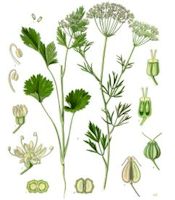 |
The Anise (Pimpinella), from "bipenella," because of its secondary, feather-like leaflets, belongs to the umbelliferous plants, and is cultivated in our gardens; but its aromatic seeds chiefly come from Germany. The careful housewife will do well always to have a supply of this most useful Simple closely bottled in her store cupboard. The herb is a variety of the Burnet Saxifrage, and yields an essential oil of a fine
blue color. To make the essence of Aniseed one part of the oil should be mixed with four parts of spirit of wine. This oil, by its chemical basis, "anethol," represents the medicinal properties of the plant. It has a special influence on the bronchial tubes to encourage expectoration, particularly with children. For infantile catarrh, after its first feverish stage, Aniseed tea is very |
useful. It should be made by pouring half-a-pint of boiling water on two teaspoonfuls of the seeds, bruised in a mortar, and given when cold in doses of one, two, or three teaspoonfuls, according to the age of the child. For the relief of flatulent stomach-ache, whether in children or in adults, from five to fifteen drops of the essence may be given on a lump of sugar, or mixed with two dessertspoonfuls of hot water. Gerard says: "The
Aniseed helpeth the yeoxing, or hicket (hiccough), and should be given to young children to eat which are like to have the falling sickness, or to such as have it by patrimony or succession." The odd literary mistake has been sometimes made of regarding Aniseed as a plural noun: thus, in "The Englishman's Doctor," it is said, "Some anny seeds be sweet, and some bitter." An old epithet of the Anise was, Solamen intestinorum "The
comforter of the bowels." The Germans have an almost superstitious belief in the medicinal virtues of Aniseed, and all their ordinary household bread is plentifully flavored with the whole seeds. The mustaceoe, or spiced cakes of the Romans, introduced at the close of a rich entertainment, to prevent indigestion, consisted of meal, with anise, cumin, and other aromatics used for staying putrescence or fermentation within the intestines.
Such a cake was commonly brought in at the end of a marriage feast; and hence the bridecake of modern times has taken its origin, though the result of eating this is rather to provoke dyspepsia than to prevent it. Formerly, in the East, these seeds were in use as part payment of taxes: "Ye pay tithe of mint, anise [dill?], and cumin!" The oil destroys lice and the itch insect, for which purpose it may be mixed with lard or spermaceti as an
ointment. The seed has been used for smoking, so as to promote expectoration.
Besides containing the volatile oil, Aniseed yields phosphates, malates, gum, and a resin. The leaves, if applied externally, will help to remove freckles; and, "Let me tell you this," says a practical writer of the present day, "if you are suffering from bronchitis, with attacks of spasmodic asthma, just send for a bottle of the liqueur called 'Anisette,' and take a dram of it with a little water. You will find it an immediate palliative;
you will cease barking like Cerberus; you will be soothed, and go to sleep." Experto crede! "I have been bronchitic and asthmatic for twenty years, and have never known an alleviative so immediately efficacious as 'Anisette.'"
For the restlessness of languid digestion, a dose of essence of Aniseed in hot water at bedtime is much to be commended. In the Paregoric Elixir, or "Compound Tincture of Camphor," prescribed as a sedative cordial by doctors (and containing some opium), the oil of Anise is also included thirty drops in a pint of the tincture. This oil is of capital service as a bait for mice.
Herb Simples
The Primitive Simplers presented here show the way of life in other generations, it is not suggested or recommended trying them yourself. |


